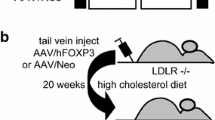Abstract
Cholesterol efflux is the first step in the reverse cholesterol transport (RCT) pathway, removing excess cholesterol from tissues, including the arterial wall, thus preventing the development of atherosclerosis. Adeno-associated virus (rAAV) has demonstrated significant promise as a DNA-delivery vector to treat serious human diseases. In this study, we constructed recombinant adeno-associated viruses coexpressing apoAI and SR-BI successfully, the double gene mRNA and protein were both strongly expressed in transduced HepG2 cells. A novel safe and efficient method of promoting the reverse cholesterol transport (RCT) may be established. These results may provide a new method for gene therapy of Arteriosclerosis.




Similar content being viewed by others
References
Fu Y, Hoang A, Escher G, Parton RG, Krozowski Z, Sviridov D (2004) Expression of Caveolin-1 enhances cholesterol efflux in hepatic cells. J Biol Chem 279:14140–14146
Basso F, Freeman L, Knapper CL, Remaley A, Stonik J, Neufeld EB, Tansey T, Amar MJA, Fruchart-Najib J, Duverger N, Santamarina-Fojo S, Brewer HB Jr (2003) Role of the hepatic ABCA1 transporter in modulating intrahepatic cholesterol and plasma HDL cholesterol concentrations. J Lipid Res 44:296–302
Barter P, Kastelein J, Nunn A, Hobbs R (2003) High density lipoproteins (HDLs) and atherosclerosis; the unanswered questions. Atherosclerosis 168:195–211
Wang X, Collins HL, Ranalletta M, Fuki IV, Billheimer JT, Rothblat GH, Tall AR, Rader DJ (2007) Macrophage ABCA1 and ABCG1, but not SR-BI, promote macrophage reverse cholesterol transport in vivo. J Clin Invest 117:2216–2224
Ji Y, Jian B, Wang N, Sun Y, Moya ML, Phillips MC, Rothblat GH, Swaney JB, Tall AR (1997) Scavenger receptor BI promotes high density lipoprotein-mediated cellular cholesterol efflux. J Biol Chem 272:20982–20985
Escher G, Krozowski Z, Croft KD, Sviridov D (2003) Expression of sterol 27-hydroxylase (CYP27A1) enhances cholesterol efflux. J Biol Chem 278:11015–11019
Major AS, Dove DE, Ishiguro H, Su YR, Brown AM, Liu L, Carter J, Linton MF, Fazio S (2001) Increased cholesterol efflux in apolipoprotein AI (ApoAI)–producing macrophages as a mechanism for reduced atherosclerosis in ApoAI(−/−) mice. Arterioscler Thromb Vasc Biol 21:1790–1795
Ishiguro H, Yoshida H, Major AS, Zhu T, Babaev VR, Linton MF, Fazio S (2001) Retrovirus-mediated expression of apolipoprotein A-I in the macrophage protects against atherosclerosis in vivo. J Biol Chem 276:36742–36748
Okazaki H, Osuga Ji, Tsukamoto K, Isoo N, Kitamine T, Tamura Y, Tomita S, Sekiya M, Yahagi N, Iizuka Y, Ohashi K, Harada K, Gotoda T, Shimano H, Kimura S, Nagai R, Yamada N, Ishibashi S (2002) Elimination of cholesterol ester from macrophage foam cells by adenovirus-mediated gene transfer of hormone-sensitive lipase. J Biol Chem 277:31893–31899
Rader DJ, Alexander ET, Weibel GL, Billheimer J, Rothblat GH (2009) The role of reverse cholesterol transport in animals and humans and relationship to atherosclerosis. J Lipid Res 50:189–194
Tangirala RK, Tsukamoto K, Chun SH, Usher D, Pure E, Rader DJ (1999) Regression of atherosclerosis induced by liver-directed gene transfer of apolipoprotein A-I in mice. Circulation 100:1816–1822
Mandel RJ, Burger C, Snyder RO (2008) Viral vectors for in vivo gene transfer in Parkinson’s disease: properties and clinical grade production. J Expneurol 209:58–71
Centlivre M, Zhou X, Pouw SM, Weijer K, Kleibeuke W, Das AT, Blom B, Seppen J, Berkhout B, Legrand N (2010) Autoregulatory lentiviral vectors allow multiple cycles of doxycycline-inducible gene expression in human hematopoietic cells in vivo. Gene Ther 17:14–25
Oka K, Davis AR, Chan L (2000) Recent advances in liver-directed gene therapy: implications for the treatment of dyslipidemia. Curr Opin Lipidol 11:179–186
Monahan PE, Samulski RJ (2000) Adeno-associated virus vectors for gene therapy: more pros than cons? Mol Med Today 6:433–440
Kay MA, Manna CS, Ragni MV, Larson PJ, Couto LB, McClell A, Glader B, Chew AJ, Tai SJ, Herzog RW et al (2000) Evidence for gene transfer and expression of factor IX in haemophilia B patients treated with an AAV vector. Nat Genet 24:257–261
Auricchio A, Hildinger M, O’Connor E, Gao GP, Wilson JM (2001) Isolation of highly infectious and pure adeno-associated virus type 2 vectors with a single-step gravity-flow column. Hum Gene Ther 12:71–76
Barter PJ, Rye K-A (1996) Molecular mechanisms of reverse cholesterol transport. Curr Opin Lipidol 7:82–87
Rothblat GH, de la Llera-Moya M, Atger V et al (1999) Cell cholesterol efflux: Integration of old and new observations provides new insights. J Lipid Res 40:781–796
Zhang Y, Yu J, Unni E, Shao TC, Nan B, Snabboon T (2002) Monogene and polygene therapy for the treatment of experimental prostate cancers by use of apoptotic genes bax and bad driven by the prostate-specific promoter ARR(2)PB. Hum Gene Ther 13:2051–2064
Pisarev AV, Shirokikh NE, Hellen CU (2005) Translation initiation by factor independent binding of eukaryotic ribosomes to internal ribosomal entry sites. C R Biol 328:589–605
Grieger JC, Choi VW, Samulski RJ (2006) Production and characterization of adeno-associated viral vectors. Nat Protoc 1:1412–1428
Buning H, BraunFalco M, Hallek M (2004) Progress in the use of adenoassociated viral vectors for gene therapy. Cells Tissues Organs 17:139–150
Acknowledgment
This work was supported by Shenzhen Institute of Xiangya Biomedicine, Shenzhen 518057, China.
Author information
Authors and Affiliations
Corresponding author
Rights and permissions
About this article
Cite this article
Li, B., Zhang, J., Li, Z. et al. Adeno-associated virus serotype 2 mediated transduction and coexpression of the human apoAI and SR-BI gene in HepG2 cells. Mol Biol Rep 39, 25–32 (2012). https://doi.org/10.1007/s11033-011-0706-5
Received:
Accepted:
Published:
Issue Date:
DOI: https://doi.org/10.1007/s11033-011-0706-5




